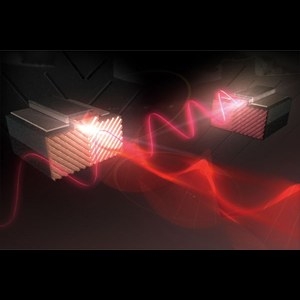News
Contact:
Michael Patrick Rutter
617-496-3815
CAMBRIDGE, Mass. – April 13, 2009 – Applied scientists at the Harvard School of Engineering and Applied Sciences (SEAS) in collaboration with researchers from Hamamatsu Photonics in Hamamatsu City, Japan, have demonstrated, for the first time, lasers in which the direction of oscillation of the emitted radiation, known as polarization, can be designed and controlled at will.
The innovation opens the door to a wide range of applications in photonics and communications. Harvard University has filed a broad patent on the invention.
Spearheaded by graduate student Nanfang Yu (above right) and Federico Capasso (above left), Robert L. Wallace Professor of Applied Physics and Vinton Hayes Senior Research Fellow in Electrical Engineering, both of SEAS, and by a team at Hamamatsu Photonics headed by Dr. Hirofumi Kan, General Manager of the Laser Group, the findings will be published as a cover feature of the April 13 issue of Applied Physics Letters.
"Polarization is one of the key features defining a laser beam. Controlling it represents an important new step towards beam engineering of lasers with unprecedented flexibility, tailored for specific applications," explains Capasso. "The novelty of our approach is that instead of being conducted externally, which requires bulky and expensive optical components, manipulation of the beam polarization is achieved by directly integrating the polarizer on the laser facet. This compact solution is applicable to semiconductor lasers and other solid-state lasers, all the way from communication wavelengths to the mid-infrared and Terahertz spectrum."
Light sources with a desirable polarization state are useful for a wide variety of applications. For example, satellite communications use two orthogonal polarizations to double the capacity of the channel; circularly-polarized light sources are necessary to detect certain biomolecules; and laser sources with a variety of polarization states have relevance for quantum cryptography.
To achieve the results, the researchers sculpted a metallic structure, dubbed a plasmonic polarizer directly on the facet of a quantum cascade (QC) laser. The QC laser emitted at a wavelength of ten microns (in the invisible part of the spectrum known as the mid-infrared where the atmosphere is transparent). The team was able to control the state of polarization by generating both linearly polarized light along an arbitrary direction and circularly polarized light.
###
The team's co-authors are postdoctoral researcher Qijie Wang and research associates Christian Pflügl and Laurent Diehl (all from Harvard) and researchers Tadataka Edamura, Sninichi Furuta, and Masamichi Yamanishi (both from Hamamatsu Photonics).
The research was partially supported by Air Force Office of Scientific Research. The authors also acknowledge the support of two Harvard-based centers, the NSF-funded Nanoscale Science and Engineering Center (NSEC) and the Center for Nanoscale Systems (CNS), a member of the National Nanotechnology Infrastructure Network (NNIN).
Additional Technical Materials
Polarization is defined as the orientation of the oscillation of the electric field in the plane perpendicular to the electromagnetic wave's direction of travel. If the tip of the electric field vector traces out a single straight line, it is called linear polarization; if the electric field vector traces out a circle in the plane, it is called circular polarization. Other situations are called elliptical polarization.
Light sources with a desirable polarization state are of high interests for many applications. For example, satellite communications use two orthogonal polarizations to double the capacity of the services; circularly-polarized light sources are of great importance in chemistry and biology for detecting molecules exhibiting circular dichroism; laser sources with a variety of polarization states are used for quantum cryptography. However, semiconductor lasers are mostly linearly-polarized along a fixed direction (determined by the optical selection rules of the gain medium). Other state of polarizations proved difficult to achieve.
Conventionally, manipulation of the polarization state of a light output is conducted externally using bulky and expensive optical components such as beam-splitting polarizers and wave plates. Our integrated plasmonic polarizer provides a compact solution allowing the development of polarization-controllable active and passive devices over a wide frequency range, from the visible to the far-infrared. The design involves the integration of an aperture-grating plasmonic structure on the emission surface of a light source.
We used mid-infrared quantum cascade lasers (QCLs) as a model system to demonstrate two types of polarization control: to filter the linearly-polarized output of a QCL to produce linearly-polarized emission along other directions and to transform a linearly-polarized QCL into a circularly-polarized device.
To project the linear polarization of a QCL into other directions we used a one-dimensional aperture-grating structure patterned on the metal-coated laser facet. The slit aperture and the straight grating grooves are oriented perpendicular to the direction that we want to project the laser polarization into. Only the component of the laser polarization perpendicular to the slit aperture/grating grooves couples to surface electromagnetic waves propagating along the grating. These surface waves are scattered into far-field by the grating grooves, and the scattered waves coherently combine in the far field to produce linearly-polarized light with the desired orientation.
A circularly polarized laser beam can be constructed by coherently combining two linearly-polarized beams satisfying three conditions: The two beams should have perpendicular polarizations, a 90-degree phase difference, and the same amplitude. These conditions can be met by defining two orthogonal aperture-grating structures on the device facet. By tailoring the separations between the aperture and the nearest groove in the two aperture-grating structures, we can control the respective phase and amplitude of the surface waves propagating along the left and the right grating, and therefore control the scattered light from the left and from the right grating to achieve circularly-polarized light in the far-field.
Cutting-edge science delivered direct to your inbox.
Join the Harvard SEAS mailing list.
